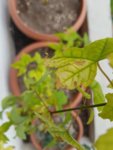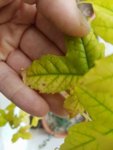Pads
Yamadori
Hi Nuts
This is the first season trying to grow trident maple seedlings. The plan is to grow a bit in nursery pots and then transfer in the ground. I have an issue with the leaves having a light green to yellow colour and browning at the tips. In one plant I have plenty of red leaves already.
Note that currently temperature range is 18-28 C and receive 7 hours direct sun. Soil ph at about 7. They are planted in 50% pumice/50% potting soil
Could this be due to excessive moisture? What do you think?


This is the first season trying to grow trident maple seedlings. The plan is to grow a bit in nursery pots and then transfer in the ground. I have an issue with the leaves having a light green to yellow colour and browning at the tips. In one plant I have plenty of red leaves already.
Note that currently temperature range is 18-28 C and receive 7 hours direct sun. Soil ph at about 7. They are planted in 50% pumice/50% potting soil
Could this be due to excessive moisture? What do you think?


